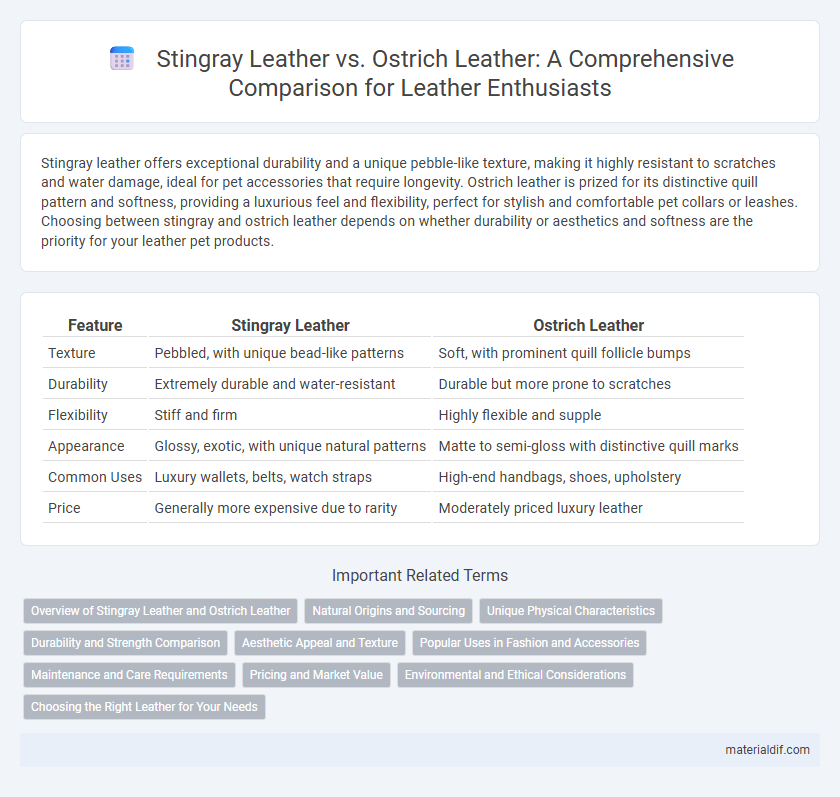Stingray leather offers exceptional durability and a unique pebble-like texture, making it highly resistant to scratches and water damage, ideal for pet accessories that require longevity. Ostrich leather is prized for its distinctive quill pattern and softness, providing a luxurious feel and flexibility, perfect for stylish and comfortable pet collars or leashes. Choosing between stingray and ostrich leather depends on whether durability or aesthetics and softness are the priority for your leather pet products.
Table of Comparison
| Feature | Stingray Leather | Ostrich Leather |
|---|---|---|
| Texture | Pebbled, with unique bead-like patterns | Soft, with prominent quill follicle bumps |
| Durability | Extremely durable and water-resistant | Durable but more prone to scratches |
| Flexibility | Stiff and firm | Highly flexible and supple |
| Appearance | Glossy, exotic, with unique natural patterns | Matte to semi-gloss with distinctive quill marks |
| Common Uses | Luxury wallets, belts, watch straps | High-end handbags, shoes, upholstery |
| Price | Generally more expensive due to rarity | Moderately priced luxury leather |
Overview of Stingray Leather and Ostrich Leather
Stingray leather is renowned for its distinctive pebbled texture and exceptional durability, often characterized by a unique, bead-like pattern caused by calcified dermal denticles. Ostrich leather stands out with its signature quill follicle bumps, offering softness, flexibility, and breathability, making it a popular choice for luxury fashion items. Both leathers provide unique aesthetic and functional benefits, with stingray leather prized for its toughness and ostrich leather celebrated for its comfort and distinctive appearance.
Natural Origins and Sourcing
Stingray leather, sourced primarily from the wild waters of Southeast Asia, is prized for its unique beaded texture formed by natural calcium deposits, reflecting its marine origin. Ostrich leather, derived from ostriches farmed mainly in South Africa, features distinct quill follicles that create a bumpy pattern, showcasing its terrestrial origin and controlled farming practices. Both materials emphasize sustainable sourcing methods, balancing ecological impact with the demand for exotic leather goods.
Unique Physical Characteristics
Stingray leather is renowned for its distinctive pebble-like texture and durable, glossy surface, often featuring a natural diamond-shaped pattern called "pearl." Ostrich leather stands out with its characteristic quill follicle pattern, creating raised bumps that provide a unique tactile quality and visual appeal. Both types of leather are prized for their toughness, but stingray leather is more resistant to water and abrasion, whereas ostrich leather offers greater flexibility and softness.
Durability and Strength Comparison
Stingray leather is renowned for its exceptional durability due to its natural armor-like texture and high resistance to abrasion, making it ideal for high-wear applications. Ostrich leather, while also durable, is prized for its flexibility and unique quill pattern but is generally less resistant to scratches and tears compared to stingray leather. In terms of strength, stingray leather outperforms ostrich leather by maintaining integrity under heavy use, while ostrich leather offers a softer, yet still robust, alternative for luxury goods.
Aesthetic Appeal and Texture
Stingray leather is characterized by its glossy, pebbled surface with a unique, naturally occurring bead-like pattern that gives it a striking, exotic look. Ostrich leather features pronounced quill follicles creating a distinctive, dimpled texture that exudes luxury and softness. Both leathers offer exceptional durability, but stingray's sleek, reflective finish contrasts with ostrich's supple, matte appearance, making each ideal for different high-end fashion applications.
Popular Uses in Fashion and Accessories
Stingray leather is prized for its durability and distinctive pebbled texture, making it a top choice for wallets, belts, and watch straps that require both toughness and visual appeal. Ostrich leather, known for its soft, supple feel and unique quill pattern, is popular for luxury handbags, boots, and jackets, offering a blend of elegance and comfort. Both leathers are favored in high-end fashion accessories, with stingray leather often used for items needing high abrasion resistance, while ostrich leather is preferred for its exotic look and softness.
Maintenance and Care Requirements
Stingray leather requires minimal maintenance due to its dense, water-resistant surface that resists scratches and stains, making it ideal for durable, low-care products. Ostrich leather demands more careful upkeep, needing regular conditioning to maintain its supple texture and distinctive quill pattern while avoiding exposure to excessive moisture or direct sunlight. Both leathers benefit from gentle cleaning with specialized leather care products to preserve their appearance and longevity.
Pricing and Market Value
Stingray leather is generally priced higher than ostrich leather due to its durability, unique texture, and rarity, making it a premium choice in luxury fashion and accessories. Ostrich leather offers a distinct quill pattern and softness, positioning it in a slightly lower price range but maintaining strong market demand for high-end products. Market value for stingray leather remains stable with niche appeal, while ostrich leather enjoys broader recognition and consistent demand in the global leather industry.
Environmental and Ethical Considerations
Stingray leather is prized for its durability and water resistance, but harvesting can impact marine ecosystems, raising concerns about overfishing and habitat disruption. Ostrich leather is sourced from farm-raised birds, which may offer more sustainable and ethical conditions, though intensive farming practices can still pose environmental challenges such as resource use and waste management. Both leathers require careful consideration of sourcing transparency, with certifications like CITES helping to ensure compliance with conservation and animal welfare standards.
Choosing the Right Leather for Your Needs
Stingray leather features a unique, pebble-like texture with exceptional durability, making it ideal for high-wear items like wallets and belts. Ostrich leather offers a luxurious, supple feel and distinctive quill patterns, preferred for fashion accessories and upholstery with an elegant appearance. Selecting the right leather depends on balancing factors such as desired texture, durability, and application, ensuring the material complements both function and style.
Stingray leather vs Ostrich leather Infographic

 materialdif.com
materialdif.com